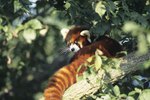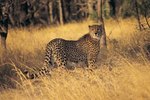When it comes to bears, one of the biggest sources of mystery and fascination is the annual hibernation. During hibernation these large mammals don't eat, eliminate or do any physical activity. Although adult bears do indeed hibernate every winter, young cubs bypass this natural survival mechanism.
Birth
Bear cubs enter the world during hibernation, typically toward the end of January or the beginning of February, according to the Yellowstone website for the National Park Service. At this point the bears are still very small, typically 8 inches long and 8 to 12 ounces. The cubs lack vision, they're devoid of fur, and they are 100 percent reliant on their hibernating mothers' care and assistance.
No Hibernation for Bear Cubs
The fast-growing young ones remain alongside mom, while nursing and resting themselves. Though the mother bears are usually asleep, they wake up occasionally to manage the needs of their cubs, whether by nursing them or by grooming them through licking. The wee cubs keep warm by staying close to their mother's stomach, indicates Peter Tyson of the Public Broadcasting Service's Nova program. The mother bear positions her back legs and paws to provide a comfortable "shelter" for the cubs.
Lighter Hibernation for Mother Bears
Mother bears hibernate very lightly compared with other bears. Because of the responsibility of taking care of the cubs, a mother bear needs to be able to easily move in and out of sleep. Apart from mother-and-cub situations, black bears fly solo when it comes to winter hibernation.
Return to the Outside World
Mother bears and their offspring usually leave their cozy dens when spring begins toward the end of March or the start of April. The cubs typically stay with their mothers for another year and a half or so to learn self-defense, how to track down food and tree climbing. Once the cubs are gone, the mothers resume the breeding process.
References
- Alaska Department of Fish and Game: Do Bears Really Sleep All Winter?
- National Park Service, Yellowstone National Park: Denning and Hibernation Behavior
- NOVA: Bear Essentials of Hibernation
- The American Bear Association: Frequently Asked Questions About Bears
- Annenberg Learner: A Year in the Life of a Black Bear
- North American Bear Center: Hidden World of Black Bears
- Maine Secretary of State Kids: Maine Black Bear
- National Park Service, Great Smoky Mountains National Park: Black Bears





